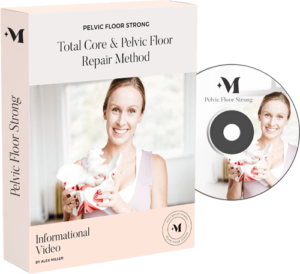Each day, Linkingo receives many emails from our readers all over the world. Today, we will share with you a story of Cindy from New Jersey. She has sent us an email and asked about “how to strengthen the pelvic floor”.
Cindy was a loving, adventurous, and enthusiastic woman. She and her husband used to share a fantastic sex life. Even after she gave birth to a boy, their burning passion never changed. That was one of the things her husband loved most about her. He once told Cindy that every time they made love, it felt just as fresh and desirous as the first time.
It seemed like Cindy had all the things a woman ever wanted: A stable job, a beautiful house, a loving husband, and a lovely child. Life was perfect for her, and she thought it would still be.
Yet it didn’t. Everything changed after Cindy gave birth to their second child.
At first, just like many ladies, she ignored the small changes in her body. She didn’t even bother when the doctor told her that her pelvic floor might have become frail after the second childbirth. Bit by bit, though, it began to take away her joy until she could no longer ignore the matter.
Before Cindy realized, she couldn’t enjoy shopping like she used to. Her need to pee kept increasing, and many times she had to run across the mall just to find a restroom. Whenever she coughs, sneezes or lifts something, urine would leak out. Needless to say, her confidence eroded. Out of the fear that she would humiliate herself right in front of people, Cindy began to isolate herself.
All of those things were distressing enough.. but not as devastating as how her husband reacted.
Ultimately, Cindy’s dysfunction led to her inability to enjoy sex. It was inevitable: There was no way she could be herself while keeping worried about the leakage. The condition did not only ruin their moment mentally but physically as well. Even her husband noticed that her inside was lopsided, and he was deeply disappointed about that. His beautiful, sexy, passionate wife was now gone.
Cindy couldn’t blame her husband but herself. As she sent her email to Linkingo, she hadn’t been sleeping well for months. The constant fear that her husband might be leaving her kept her wide awake. Her life now felt like a living nightmare. She had been seeking how to strengthen the pelvic floor and desperately needed our support.
Reading her email broke our hearts. With every word she wrote, it sounded like a cry for help. Even worse, her story can be many people’s stories.
Many female readers might empathize with this story. That’s because weakened pelvic floor (or pelvic floor dysfunction) is a prevalent condition for women. A pelvic floor is a group of muscles between the tailbone and the pubic bone within the pelvic. Their role is to support our bowel and bladder. The condition occurs when these muscles can no longer relax and coordinate to urinate or have a bowel movement.
According to surveys, around 25% of US women now face this issue, which is very high. While being a prevalent condition, the damage pelvic floor dysfunction brings to patients’ life cannot be denied. Painful urination and constipation can ruin their overall health slowly.
Not only do they have to suffer physically, but mentally as well. Many of Linkingo’s readers wrote that uncontrollable leaking made them feel humiliated. Worst of all, they were unable to enjoy sex. While scientists have not found any link between pelvic floor dysfunction and sexual impotence, the lack of confidence and diminished body image ultimately leads to libido loss. With that being said, Cindy‘s email is the story of every woman who faces this condition.
That’s why today, Linkingo’s experts will provide an in-depth analysis of all the treatments for pelvic floor dysfunction, both medical and non-medical ones. After reading this post, you can familiarize yourself with each method, understand its pros and cons, and know which one is most suitable. If you have been living with this condition, worry not, we got your back!
-
Medications.
Of course, one of the most common treatments for pelvic floor dysfunction is medications. To deal with the condition, doctors often prescribe pills that soften the bowel’s movements. The most popular ones are MiraLAX, Colace, or Senna.
As mentioned above, pelvic floor dysfunction often comes with constipation. These medicines focus on solving this problem. They work by boosting the amount of water the stool absorbs in the gut, making the stool softer and easier to pass.
The inability to relax and coordinate your pelvic muscles makes it hard to have a bowel movement. However, chronic straining from constipation also weakens these muscles. It is like a vicious cycle. That explains why medications are a crucial part of treating pelvic floor dysfunction. However, these medicines only deal with the symptoms, not the root cause of the condition. So far, there is no over-the-counter medication that can strengthen your pelvic floor and solve the dysfunction permanently.
Stool softeners may contain active ingredients. Users must check the ingredient list carefully and discuss it with their doctors to avoid any allergic reaction or other problems. Please note that these medicines can come with side effects such as stomach pain, diarrhea, or cramping. More severe effects include rectal bleeding, severe dizziness, and trouble breathing.
-
Electrical Stimulation.
There are two types of pelvic floor dysfunction: Tight/overactive and low tone/underactive. Electrical stimulation is a painless procedure that deals with the former. It uses a low-grade electrical device to stimulate pelvic muscles and create a muscle response that resembles Kegels. This progress tightens your pelvic floor muscles and reinforces them. Hence, it is effective in improving urinary frequency, urgency, or incontinence.
The procedure doesn’t only strengthen pelvic floor muscles but also women’s vaginal muscles. However, it is only effective if your pelvic floor dysfunction is the result of an overactive bladder condition. This method is not recommended for pregnant women or patients who are using a pacemaker. Though there are no proven side effects, some studies suggest that electrical stimulation might negatively affects female sexual response.
-
Surgery.
In sporadic cases when pelvic floor dysfunction result from rectal prolapse or rectocele, patients might need to go through a pelvic floor reconstruction surgery. It is a major surgical procedure when doctors address all the prolapsing organs and either reconstruct your muscle layers or eliminate your fallen organs.
Surgery strategies will be considered depending on the location of your prolapse. Basically, there are four types:
- Posterior prolapse.
- Anterior prolapse.
- Uterine prolapse.
- Vaginal vault prolapse.
Please note that pelvic floor reconstruction is a short-term method, as it only repairs your tissue bulge. Since the procedure cannot heal the underlying weakened tissues, recurrent prolapse is not uncommon. After undergoing surgery, you might still experience pain in your lower body for a few weeks. Other side effects include infertility, dyspareunia, mesh exposure, voiding dysfunction, and de novo urgency.
The cost for one procedure is also high: The average direct price is around $4658 and keeps rising over the year. For the high risk of complications and the cost, surgery should only be considered the last resort when the patient’s rectal prolapse is too severe.
-
Biofeedback.
Biofeedback is a non-invasive, non-surgical treatment that focuses on helping patients strengthen or relax their group of muscles. Hence, they can improve their bowel movement or bladder function and reduce some pelvic floor pains.
The process involves two sensors, one on the abdomen and another in the anal canal. Their job is to measure the electrical activity of your pelvic muscles that are in charge of bowel and bladder functions. As you tighten or relax the muscles, changes are visualized on the computer monitor. A specifically trained nurse shall assist you in reading this information and identifying the correct muscles. From there, you shall make the changes that can improve their movements.
Often a session of biofeedback will last for an hour. Patients will initially be scheduled for four weekly sessions and more if required. But your job doesn’t end here. At the end of each session, you will have a list of exercises you need to perform at home. Unless you practice them actively, you can not improve your pelvic floor muscles. In short, this method is only suitable for people who can invest a certain amount of time and effort.
The cost of this method is relatively high, around $1250 for an evaluation with neurologist reports. For that reason, though it poses no side effects and can potentially improve pelvic floor dysfunction, this method is not too popular among patients.
-
Pelvic Floor Physical Therapy.
Physical therapy is often a part of biofeedback therapy. From the reactions shown on the screen, your physician will determine which muscles in your pelvic floor need to be improved and teach you movement to tighten or relax them. However, they can also be practiced separately.
Some of the relaxation techniques such as meditation, yoga, and exercises are recommended as well. In fact, many patients seek help from physical therapy for several reasons:
Firstly, they do not pose any side effects like conventional treatments. Exercises, if done correctly, can improve the condition naturally while strengthening your overall health.
Secondly, they can be done in the comfort of your home and whenever you have free time. Users don’t have to follow a time. Instead, they can create their own schedule to practice.
Thirdly, it doesn’t cost money. As mentioned above, some conventional treatments can be costly. By applying exercises at home, patients can save themselves from spending a considerable amount on medications and procedures.
For those reasons, physical therapy seems to be the most suitable method for everyone. However, it is challenging for patients to know what exactly are exercises that can help them. There are numerous guides on how to strengthen the pelvic floor using physical therapy on the internet. Yet, not so many seem to be created by qualified experts. Incorrect practicing can be more dangerous than you think. Some abdominal exercises put too much pressure on your pelvic floor muscles, leading to more severe bladder leaks. Hence, you have a high risk of worsening the condition if you don’t be careful on which one to practice.
Like many people suffering from pelvic floor dysfunction, Cindy also assumed that practicing exercises might be the best option for her. Unfortunately, when she asked the doctor about this, her instruction seemed to be so vague. While scientists have confirmed that movements can effectively strengthen your pelvic muscles, physicians insist that they only play a support role. Therefore, they wouldn’t give you much advice.
She had no other way but to seek help from the internet. Just when Cindy got lost in the sea of information, she found an online program that received much positive feedback from users worldwide.
That Program Is Pelvic Floor Strong.
Cindy could empathize deeply with the story behind this product. Alex Miller, the creator of Pelvic Floor Strong, introduced herself as a fitness instructor and women’s health specialist from Vancouver, Canada. As expected from a health expert, this woman possessed an attractive look and a strong personality. Just by looking at Alex, one might think that she had every important thing in life. But Alex Miller was not that lucky. To become the person she was today, Alex had to trade with her blood, sweat, and tears.
“If you met me a few years ago, you wouldn’t recognize me”, Alex wrote. That was the worst time in her life when Alex’s mom had triple-negative breast cancer, a rare, life-threatening, and aggressive disease. No one could withstand this pain, not even a bright woman like Alex. Alex’s heart was broken as her dearest mom suffered from countless surgeries, destructive thermography, and painful radiation. She couldn’t even eat or sleep properly because every time she thought about her mom, tears would stream down her cheeks. But the pain didn’t only destroy her emotionally, but physically as well.
A horrific turn of events occurred on a spring day. Alex was teaching her fitness class, trying to forget the pain for just a few hours. Just as she yelled out with encouragement to her students, she accidentally peed herself. Never in her life did Alex suffer from such a humiliation. That was how she discovered she had pelvic floor dysfunction in the worst way possible.
The only thing that set Alex apart from other women was that she didn’t give up. She didn’t let fear and humiliation ruin her life forever. Instead, she held onto her pride as a health specialist. With only her knowledge, to begin with, Alex worked with other experts and consulted the best doctors worldwide, trying to find the best way to cure pelvic floor dysfunction. She didn’t do it for herself, but for other women like Cindy, since many were fighting against it in vain.
The Pelvic Floor Strong was the result Alex proudly introduced. This program is a set of exercises that focus entirely on healing your layer syndrome and stop your leaking problem holistically. It seems to meet all the requirements listed above: Safe, flexible, and economical. Most importantly, Pelvic Floor Strong is the brainchild of a real specialist who shared the same experience with patients.

>>> Click Here To Access The Pelvic Floor Strong Program <<<
Of course, Cindy was eager to purchase the Pelvic Floor Strong. It might be the guide on how to strengthen the pelvic floor that she needs. However, since it was all about her health, she didn’t want to be careless. There were still many questions surrounding the program, such as:
- Is it based on actual science? How does Alex know that her exercises can be effective in treating pelvic floor dysfunction?
- Are the exercises simple to practice? Does it take much time?
- What if it is not for everyone?
- Does it really work? How long does it take to see the result?
- Where is the best place to purchase this program?
We value Cindy’s concerns and appreciate the trust she placed in Linkingo. That’s why our experts took on the mission to check out the program. After spending many hours researching this product, we decided to buy and experience the real deal. Our detailed review contains all the information about the creator, the hidden story that you could never find anywhere, as well as our actual experience. You shouldn’t click the link if you haven’t prepared for a wall of text, though, since this is the most comprehensive Pelvic Floor Strong review you can’t find anywhere!
Our Final Thoughts
It comes to the end of our guide on how to strengthen the pelvic floor for women. Briefly, there are five methods: Medications, electrical stimulation, surgery, biofeedback, and physical therapy. Among the five methods, the easiest, most convenient one is by far physical therapy.
Don’t miss out our latest article on “6 most effective pelvic floor exercises for women“
Your support is our encouragement, so if you find this article helpful, please like and share! Don’t hesitate to leave a comment below if you have other suggestions.
We look forward to seeing you in our next posts.






Leave a Reply